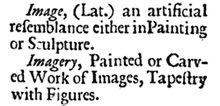Image
An image (from Latin: imago) is an artifact that depicts visual perception, such as a photograph or other two-dimensional picture, that resembles a subject—usually a physical object—and thus provides a depiction of it. In the context of signal processing, an image is a distributed amplitude of color(s).[1] A pictorial script is a writing system that employs images as symbols for various semantic entities, rather than the abstract signs used by alphabets.


Characteristics
Images may be two-dimensional, such as a photograph or screen display, or three-dimensional, such as a statue or hologram. They may be captured by optical devices – such as cameras, mirrors, lenses, telescopes, microscopes, etc. and natural objects and phenomena, such as the human eye or water.
The word 'image' is also used in the broader sense of any two-dimensional figure such as a map, a graph, a pie chart, a painting or a banner. In this wider sense, images can also be rendered manually, such as by drawing, the art of painting, carving, rendered automatically by printing or computer graphics technology, or developed by a combination of methods, especially in a pseudo-photograph.
A volatile image is one that exists only for a short period of time. This may be a reflection of an object by a mirror, a projection of a camera obscura, or a scene displayed on a cathode ray tube. A fixed image, also called a hard copy, is one that has been recorded on a material object, such as paper or textile by photography or any other digital process.
A mental image exists in an individual's mind, as something one remembers or imagines. The subject of an image need not be real; it may be an abstract concept, such as a graph, function, or imaginary entity. For example, Sigmund Freud claimed to have dreamed purely in aural-images of dialogs.
The development of synthetic acoustic technologies and the creation of sound art have led to a consideration of the possibilities of a sound-image made up of irreducible phonic substance beyond linguistic or musicological analysis. There are Two Types of Images a. Still Image b. Moving Image
Still or moving
A still image is a single static image. This phrase is used in photography, visual media and the computer industry to emphasize that one is not talking about movies, or in very precise or pedantic technical writing such as a standard.
A moving image is typically a movie (film) or video, including digital video. It could also be an animated display such as a zoetrope.
A still frame is a still image derived from one frame of a moving one. In contrast, a film still is a photograph taken on the set of a movie or television program during production, used for promotional purposes.
Imagery (literary term)
In literature, imagery is a "mental picture" which appeals to the senses.[2] It can both be figurative and literal.[2]
See also

- Cinematography
- Computer-generated imagery
- Digital image
- Fine-art photography
- Graphics
- Image editing
- Photograph
- Satellite image



References
- Chakravorty, Pragnan (September 2018). "What is a Signal? [Lecture Notes]". IEEE Signal Processing Magazine. 35 (5): 175–77. doi:10.1109/MSP.2018.2832195.
- Chris Baldick (2008). The Oxford Dictionary of Literary Terms. Oxford University Press. pp. 165–. ISBN 978-0-19-920827-2.